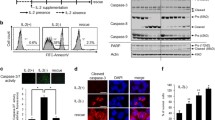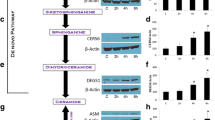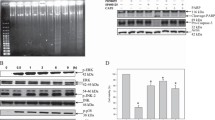Abstract
It has been previously reported that treatment of CHP-100 human neuroepithelioma cells with N-hexanoylsphingosine (C6-Cer) induces intracellular accumulation of long-chain ceramide (LC-Cer) and apoptosis. Herein, we investigated the existence of any causal relationship between the two phenomena. We report that C6-Cer-evoked LC-Cer accumulation is potently attenuated by the ceramide synthase inhibitor fumonisin B1; however, fumonisin B1 neither affects the apoptotic response evoked by C6-Cer administration, nor is toxic by itself to CHP-100 cells. Different to fumonisin B1, the serine-palmitoyltransferase inhibitor l-cycloserine does not attenuate C6-Cer-evoked LC-Cer accumulation, thus suggesting that LC-Cer is produced via the sphingosine salvage pathway. Consistently, CHP-100 cells accumulate LC-Cer in response to sphingosine administration; however, their viability is not affected. The above-reported results indicate that, in the cell system investigated, C6-Cer, but not LC-Cer, is involved in apoptosis induction. As this finding is discussed in the light of the evidence that C6-Cer-induced apoptosis associates with cytochrome c release into the cytosol and caspase-9 activation, thus calling for an involvement of the mitochondrial pathway, it also lends support to the notion that caution must be exercised when investigating the biological effects of endogenous ceramide by use of exogenously administered short-chain analogues.






Similar content being viewed by others
Abbreviations
- C6-Cer:
-
N-Hexanoylsphingosine
- LC-Cer:
-
Long-chain ceramide
- FB1:
-
Fumonisin B1
- l-CS:
-
l-Cycloserine
- HPTLC:
-
High-performance thin layer chromatography
- PARP:
-
Poly-(ADP)ribose polymerase
- FITC:
-
Fluorescein isothiocyanate
- PBS:
-
Phosphate buffered saline
- Ac-LEHD-AFC:
-
Acetyl-Leu-Glu-His-Asp-amido-4-trifluoromethyl-coumarin
References
Perry DK, Hannun YA (1998) The role of ceramide in cell signalling. Biochim Biophys Acta 1436:233–243
Posse de Chaves EI (2006) Sphingolipids in apoptosis, survival and regeneration in the nervous system. Biochim Biophys Acta 1758:1995–2015
van Blitterswijk WJ, van der Luit AH, Veldman RJ, Verheij M, Borst J (2003) Ceramide: second messenger or modulator of membrane structure and dynamics? Biochem J 369:199–211
Abe A, Wu D, Shayman JA, Radin NS (1992) Metabolic effects of short-chain ceramide and glucosylceramide on sphingolipids and protein kinase C. Eur J Biochem 210:765–773
Ridgway ND, Merriam DL (1995) Metabolism of short-chain ceramide and dihydroceramide analogues in Chinese hamster ovary (CHO) cells. Biochim Biosphys Acta 1256:57–70
Jaffrézou JP, Maestre N, de Mas-Mansat V, Bezombes C, Levade T, Laurent G (1998) Positive feedback control of neutral sphingomyelinase activity by ceramide. FASEB J 12:999–1006
Spinedi A, Di Bartolomeo S, Piacentini M (1998) Apoptosis induced by N-hexanoylsphingosine in CHP-100 cells associates with accumulation of endogenous ceramide and is potentiated by inhibition of glucocerebroside synthesis. Cell Death Differ 5:785–791
Ogretmen B, Pettus BJ, Rossi MJ, Wood R, Usta J, Szulc Z, Bielawska A, Obeid LM, Hannun YA (2002) Biochemical mechanisms of the generation of endogenous long chain ceramide in response to exogenous short chain ceramide in the A549 human lung adenocarcinoma cell line: role for endogenous ceramide in mediating the action of exogenous ceramide. J Biol Chem 277:12960–12969
Sultan I, Senkal CE, Ponnusamy S, Bielawski J, Szulc Z, Bielawska A, Hannun YA, Ogretmen B (2006) Regulation of the sphingosine-recycling pathway for ceramide generation by oxidative stress, and its role in controlling c-Myc/Max function. Biochem J 393:513–521
Takeda S, Mitsutake S, Tsuji K, Igarashi Y (2006) Apoptosis occurs via the ceramide recycling pathway in human HaCaT keratinocytes. J Biochem 139:255–262
Folch J, Lees M, Sloane-Stanley GH (1957) A simple method for the isolation and purification of total lipides from animal tissues. J Biol Chem 266:497–509
Macala LJ, Yu RK, Ando S (1983) Analysis of brain lipids by high performance thin layer chromatography and densitometry. J Lipid Res 24:1243–1250
Herget T, Esdar C, Oehrlein SA, Heinrich M, Schütze S, Maelicke A, van Echten-Deckert G (2000) Production of ceramides causes apoptosis during early neural differentiation in vitro. J Biol Chem 275:30344–30354
Marinetti GV (1962) Chromatographic separation, identification, and analysis of phosphatides. J Lipid Res 3:1–20
Di Bartolomeo S, Di Sano F, Piacentini M, Spinedi A (2000) Apoptosis induced by doxorubicin in neurotumor cells is divorced from drug effects on ceramide accumulation and may involve cell cycle-specific caspase activation. J Neurochem 75:532–539
Lowry OH, Rosebrough NJ, Farr AL, Randall RJ (1951) Protein measurement with the Folin phenol reagent. J Biol Chem 193:265–275
Mohan J, Gandhi AA, Bhavya BC, Rashmi R, Karunagaran D, Indu R, Santhoshkumar TR (2006) Caspase-2 triggers Bax-Bak-dependent and -independent cell death in colon cancer cells treated with resveratrol. J Biol Chem 281:17599–17611
Hinkovska-Galcheva V, Boxer L, Mansfield PJ, Schreiber AD, Shayman JA (2003) Enhanced phagocytosis through inhibition of de novo ceramide synthesis. J Biol Chem 278:974–982
Wang E, Norred WP, Bacon CW, Riley RT, Merril AH Jr (1991) Inhibition of sphingolipid biosynthesis by fumonisins. J Biol Chem 266:14486–14490
Kitatani K, Idkowiak-Baldys J, Hannun YA (2008) The sphingolipid salvage pathway in ceramide metabolism and signalling. Cell Signal 20:1010–1018
Di Bartolomeo S, Spinedi A (2002) Ordering ceramide-induced cell detachment and apoptosis in human neuroepithelioma. Neurosci Lett 334:149–152
Slee EA, Harte MT, Kluck RM, Wolf BB, Casiano CA, Newmeyer DD, Wang HG, Reed JC, Nicholson DW, Alnemri ES, Green DR, Martin SJ (1999) Ordering the cytochrome c-initiated caspase cascade: hierarchical activation of caspases-2, -3, -6, -7, -8, and -10 in a caspase-9-dependent manner. J Cell Biol 144:281–292
Le Stunff H, Giussani P, Maceyka M, Lépine S, Milstien S, Spiegel S (2007) Recycling of sphingosine is regulated by the concerted actions of sphingosine-1-phosphate phosphohydrolase 1 and sphingosine kinase 2. J Biol Chem 282:34372–34380
Pewzner-Jung Y, Ben-Dor S, Futerman AH (2006) When do Lasses (longevity assurance genes) become CerS (ceramide synthases)? Insights into the regulation of ceramide synthesis. J Biol Chem 281:25001–25005
Siskind LJ (2005) Mitochondrial ceramide and the induction of apoptosis. J Bioenerg Biomembr 37:143–153
Lipsky NG, Pagano RE (1983) Sphingolipid metabolism in cultured fibroblasts: microscopic and biochemical studies employing a fluorescent ceramide analogue. Proc Natl Acad Sci USA 80:2608–2612
Birbes H, El Bawab S, Hannun YA, Obeid LM (2001) Selective hydrolysis of a mitochondrial pool of sphingomyelin induces apoptosis. FASEB J 15:2669–2679
Dai Q, Liu J, Chen J, Durrant D, McIntyre TM, Lee RM (2004) Mitochondrial ceramide increases in UV-irradiated HeLa cells and is mainly derived from hydrolysis of sphingomyelin. Oncogene 23:3650–3658
Stiban J, Caputo L, Colombini M (2008) Ceramide synthesis in the endoplasmic reticulum can permeabilize mitochondria to proapoptotic proteins. J Lipid Res 49:625–634
van Echten-Deckert G, Herget T (2006) Sphingolipid metabolism in neural cells. Biochim Biophys Acta 1758:1978–1994
Bladergroen BA, Bussière M, Klein W, Geelen MJ, Van Golde LM, Houweling M (1999) Inhibition of phosphatidylcholine and phosphatidylethanolamine biosynthesis in rat-2 fibroblasts by cell-permeable ceramides. Eur J Biochem 264:152–160
Ramos B, El Mouedden M, Claro E, Jackowski S (2002) Inhibition of CTP:phosphocholine cytidylyltransferase by C(2)-ceramide and its relationship to apoptosis. Mol Pharmacol 62:1068–1075
Cui Z, Houweling M (2002) Phosphatidylcholine and cell death. Biochim Biophys Acta 1585:87–96
Hu W, Xu R, Zhang G, Jin J, Szulc ZM, Bielawski J, Hannun YA, Obeid LM, Mao C (2005) Golgi fragmentation is associated with ceramide-induced cellular effects. Mol Biol Cell 16:1555–1567
Spinedi A, Amendola A, Di Bartolomeo S, Piacentini M (1998) Ceramide-induced apoptosis is mediated by caspase activation independently from retinoblastoma protein post-translational modification. Biochem Biophys Res Commun 243:852–857
Acknowledgments
This work was partly supported by MIUR (Ministero dell’Istruzione dell’Università e della Ricerca) funds (60%) to Angelo Spinedi.
Author information
Authors and Affiliations
Corresponding author
About this article
Cite this article
Mancinetti, A., Di Bartolomeo, S. & Spinedi, A. Long-chain Ceramide Produced in Response to N-Hexanoylsphingosine does not Induce Apoptosis in CHP-100 Cells. Lipids 44, 1039–1046 (2009). https://doi.org/10.1007/s11745-009-3350-2
Received:
Accepted:
Published:
Issue Date:
DOI: https://doi.org/10.1007/s11745-009-3350-2




